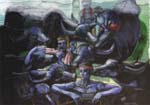 Bengal Gallery of Fine Arts and Bangladesh Embassy in Seoul (South Korea) have jointly organised a group art exhibition, titled “Contemporary Paintings of Bangladesh”, featuring works of Quayyum Chowdhury, Samarjit Roy Chowdhury, Hashem Khan, Rafiqun Nabi, Monirul Islam, Mahmudul Haque, Shahid Kabir, Farida Zaman, Rokeya Sultana, Dilara Begum Jolly, Kanak Chanpa Chakma and Mohammad Iqbal. The exhibition is now on at Korea Cultural Centre in Seoul.
Bengal Gallery of Fine Arts and Bangladesh Embassy in Seoul (South Korea) have jointly organised a group art exhibition, titled “Contemporary Paintings of Bangladesh”, featuring works of Quayyum Chowdhury, Samarjit Roy Chowdhury, Hashem Khan, Rafiqun Nabi, Monirul Islam, Mahmudul Haque, Shahid Kabir, Farida Zaman, Rokeya Sultana, Dilara Begum Jolly, Kanak Chanpa Chakma and Mohammad Iqbal. The exhibition is now on at Korea Cultural Centre in Seoul.
Prior to leaving for Seoul, the paintings were shown at the Bengal Gallery of Fine Arts in Dhanmondi, Dhaka.
Samarjit Roy Chowdhury’s geometric compositions and management of space on canvas denote dreams, reality and nostalgia. Blue, red, white and black have been used mostly. The paintings featured at the Seoul exhibition highlight Chowdhury’s use of colour and form. Blending of traditional elements and modern geometric/abstract forms is a characteristic of his paintings.
Rafiqun Nabi’s paintings project rural people and their lifestyle. Fishermen, peasants, cowherds and their everyday joys, sorrows get the focus in his works. The artist likes to use azure, yellow, ochre, red, black and emerald. As part of his experiment, different kinds of boats and livestock are also seen in his paintings. Nabi has been eagerly studying movements of figures and arrangements of compositions. He is very meticulous about his compositions.
Monirul Islam controls his mediums and techniques with a certain mastery. His featured work at the exhibition witnesses a dominance of black and gray. The artist has worked with sharp lines, doodles, geometric and architectural forms, and a lot of symbols — transforming expressions. The exhibition includes his “Death of a River”, an acrylic piece with powerful lines and subdued colours. Tranquility and lucidity are major characteristics of his paintings and printmaking (particularly etching and aquatint).
Mahmudul Haque has a fondness for compositions and forms. His paintings can be categorised according to the use of forms and compositions. His works delve deep into the imaginary world and are remarkable for the artist’s signature turquoise composition. Tiny vague forms make his paintings more interesting. At the exhibition his “Joy of Creation-2” presents a flat space with subtle colours as well as thick textures.
Kanak Chanpa Chakma has attained recognition for her portrayal of ethnic communities and life in the hills. The artist likes to play with colours and figures according to the subjects’ requirements. Her approach (mainly figures) is realistic but the backdrop and setting of composition seemingly adhere to expressionism. At the exhibition, her “Maidens of the Sea-5” shows two indigenous girls — one playing a flute and other concentrating on the tune.
Mohammad Iqbal’s recent subject of choice is children, whom he considers to be often neglected. At the exhibition, this particular subject has been addressed; at times with abhorrence against unfairness, and often with anxiety and rage caused by it. “Children are a symbol of hope. Their existence depends on a world devoid of war and brutality. Many children die every year in wars and conflicts. It makes me cry when I see children in inhuman conditions,” says the artist. At the exhibition, his “Distant Skies” depicts the visages of three children — the focal point of the painting. The lower part of the painting features scribbles and some unusual forms.
The exhibition in Seoul ends today.
Courtesy of The Daily Star




















